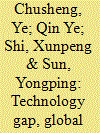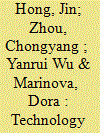|
|
|
Sort Order |
|
|
|
Items / Page
|
|
|
|
|
|
|
| Srl | Item |
| 1 |
ID:
192509


|
|
|
|
|
| Summary/Abstract |
This paper examines the content and driving forces of the "Made in China 2025" plan adopted by China's State Council in 2015, discusses the key goals of the plan and the main factors influencing its implementation, and elucidates the areas and stages of development of the industrial technology base. It also shows the status of the participation of military-industrial corporations in the implementation of the plan and gives examples of specific achievements of industrial and technological leaders in competition with developed countries on international markets.
This paper also provides evidence of how military-civilian integration under the leadership of Chinese President Xi Jinping has accelerated the technological development of both civilian and defense industries of the PRC and serves as an important stimulus for industrial development in China.
The author examines specifics of the implementation of the plan in 10 major areas, such as robotics, aerospace, shipbuilding, information technology, rail transport, industries related to energy conservation, biotechnology, medicine, etc.
|
|
|
|
|
|
|
|
|
|
|
|
|
|
|
|
| 2 |
ID:
090796


|
|
|
|
|
| Publication |
2009.
|
| Summary/Abstract |
This paper proposes a new insight that the technology gap plays double-edged roles in the technology spillovers of foreign direct investment (FDI) through two channels, technology choice set and technology absorptive capability. Applying a multiple-threshold model, we examine the non-linear relationship between the technology gap and technology spillovers based on the provincial panel data of the Chinese industrial sector during 1993-2006. The empirical results support the hypothesis of two thresholds, which are 0.3071 and 0.5214 in terms of the technology gap respectively. The estimated thresholds indicate the sufficient absorptive capability is the premise for FDI technology spillovers. Moreover, it implies the marginal decrease of FDI technology spillover effects in the long run.
|
|
|
|
|
|
|
|
|
|
|
|
|
|
|
|
| 3 |
ID:
088283


|
|
|
|
|
| Publication |
2009.
|
| Summary/Abstract |
Evaluation of global diffusion potential of learning technologies and their timely specific cost development across regions is always a challenging issue for the future technology policy preparation. Further the process of evaluation gains interest especially by endogenous treatment of energy technologies under uncertainty in learning rates with technology gap across the regions in global regional cluster learning approach. This work devised, implemented, and examined new methodologies on technology gaps (a practical problem), using two broad concepts of knowledge deficit and time lag approaches in global learning, applying the floor cost approach methodology. The study was executed in a multi-regional, technology-rich and long horizon bottom-up linear energy system model on The Integrated MARKAL EFOM System (TIMES) framework. Global learning selects highest learning technologies in maximum uncertainty of learning rate scenario, whereas any form of technology gap retards the global learning process and discourages the technologies deployment. Time lag notions of technology gaps prefer heavy utilization of learning technologies in developed economies for early reduction of specific cost. Technology gaps of any kind should be reduced among economies through the promotion and enactment of various policies by governments, in order to utilize the technological resources by mass deployment to combat ongoing climate change.
|
|
|
|
|
|
|
|
|
|
|
|
|
|
|
|
| 4 |
ID:
106920


|
|
|
|
|
| Publication |
2011.
|
| Summary/Abstract |
We have examined the way in which local firms in China's handset industry, confronted with a technology gap, have achieved growth, using the concept of boundaries of the firm. Chinese local firms have lacked technology, and have therefore turned to outside firms for development, design, and manufacturing in some cases. On the other hand, they themselves have focused on sales and marketing, using their advantage of familiarity with the home market. Consequently, by establishing a growth condition in which their selection of boundaries counterbalances the technology gap, they have been able to expand their market shares in comparison with foreign firms.
|
|
|
|
|
|
|
|
|
|
|
|
|
|
|
|
| 5 |
ID:
093649


|
|
|
|
|
| Publication |
2009.
|
| Summary/Abstract |
Has China's strategy of 'exchanging market for technology' been successful? This paper analyses the effectiveness of this strategy based on the duopoly model of vertical product differentiation by Choi and Shin (1992). It is shown that the outcome is influenced by technology gap and absorptive capacity. The profit of a developing country firm shows an inverted U-shaped relationship with its technology level when holding the foreign firm's technology level constant. In the process of technology improvement by imitation, the developing country firm faces a limit on imitation. A developing country may benefit from the strategy of 'exchanging market for technology' at the early stage and needs to bring in FDI with advanced technology so that it can overcome restraints from the limit of imitation. For one with a smaller technology gap with the home country of FDI, the country in the long run has to achieve technological progress through innovation.
|
|
|
|
|
|
|
|
|
|
|
|
|
|
|
|
| 6 |
ID:
171435


|
|
|
|
|
| Summary/Abstract |
The technological progress of a country may mean that its technology gap compared to the frontier has changed, which will induce a change in its positioning in the global value chain and affect its carbon intensity. Using paten data, Input Output Database and the Global Value Chain Index, we employ systematic Generalized Method of Moments, quantile regression with panel data and multilevel mediation analysis to measure empirically the impact of the technology gap on carbon intensity and positioning on the global value chain. The empirical analysis shows that narrowing the technology gap will reduce significantly a country's carbon intensity. Further, the effect of the technology gap on carbon intensity is more pronounced on industries with higher carbon intensity. The mechanism test using the mediation effect model proves that the impact of the technology gap on carbon intensity is achieved by changing in the position of global value chain. The findings suggest that a country's carbon intensity performance is not only affected by its own technological progress, but also by global frontiers. Therefore, a country should not only pay attention to its own technological progress but also to the development of global frontier technologies and speed of technological progress.
|
|
|
|
|
|
|
|
|
|
|
|
|
|
|
|
| 7 |
ID:
164724


|
|
|
|
|
| Summary/Abstract |
This research adds to the literature studying the effects of outward foreign direct investment (OFDI) on domestic innovation performance and the moderating effect of a technology gap between host and home countries. New definitions of observed technology gap and expected technology gap are proposed. An observed technology gap captures the existing differences in technology level between establishments, regions or countries. An expected technology gap is an indication of the effort of imitating and learning from technology leaders. The corresponding measures and effects of observed and expected technology gaps on OFDI‐induced reverse technology spillover are analyzed. OFDI in developed countries promotes innovation performance. However, OFDI in emerging markets hampers innovation performance. It is also found that regions with a wider observed technology gap and a narrower expected technology gap can benefit more from OFDI.
|
|
|
|
|
|
|
|
|
|
|
|
|
|
|
|
|
|
|
|
|